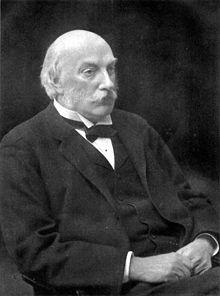
Back John William Strutt, 3de Baron van Rayleigh Afrikaans John William Strutt AN جون ويليام ستروت ريليه Arabic جون ويليام ستروت ARZ Con Vilyam Strett Azerbaijani جان استرات AZB John William Strutt, Baron Rayleigh Ka-3 BAN Джон Уільям Стрэт (лорд Рэлей) Byelorussian Джон Ўільям Стрэт (лорд Рэйлі) BE-X-OLD Джон Уилям Стрът Bulgarian
The Lord Rayleigh | |
|---|---|
 Rayleigh in 1904 | |
| Chancellor of the University of Cambridge | |
| In office 1908–1919 | |
| Preceded by | Spencer Cavendish, 8th Duke of Devonshire |
| Succeeded by | Arthur Balfour, 1st Earl of Balfour |
| 39th President of the Royal Society | |
| In office 1905–1908 | |
| Preceded by | Sir William Huggins |
| Succeeded by | Sir Archibald Geikie |
| Personal details | |
| Born | John William Strutt 12 November 1842 Maldon, Essex, England |
| Died | 30 June 1919 (aged 76) Terling Place, Witham, Essex, England |
| Alma mater | |
| Known for |
|
| Spouse |
Evelyn Balfour (m. 1871) |
| Children | 3, including Robert |
| Awards |
|
| Scientific career | |
| Fields | Physics Mathematics |
| Institutions |
|
| Academic advisors | |
| Notable students | |
| 2nd Cavendish Professor of Physics | |
| In office 1879–1884 | |
| Preceded by | James Clerk Maxwell |
| Succeeded by | J. J. Thomson |
| Signature | |
 | |
John William Strutt, 3rd Baron Rayleigh (/ˈreɪli/; 12 November 1842 – 30 June 1919), was an English physicist and mathematician. He spent all of his academic career at the University of Cambridge. Among many honours, he received the Nobel Prize in Physics in 1904 "for his investigations of the densities of the most important gases and for his discovery of argon in connection with these studies". He served as president of the Royal Society from 1905 to 1908 and as chancellor of the University of Cambridge from 1908 to 1919.
Rayleigh provided the first theoretical treatment of the elastic scattering of light by particles much smaller than the light's wavelength, a phenomenon now known as "Rayleigh scattering", which notably explains why the sky is blue. He studied and described transverse surface waves in solids, now known as "Rayleigh waves". He contributed extensively to fluid dynamics, with concepts such as the Rayleigh number (a dimensionless number associated with natural convection), Rayleigh flow, the Rayleigh–Taylor instability, and Rayleigh's criterion for the stability of Taylor–Couette flow. He also formulated the circulation theory of aerodynamic lift. In optics, Rayleigh proposed a well-known criterion for angular resolution. His derivation of the Rayleigh–Jeans law for classical black-body radiation later played an important role in the birth of quantum mechanics (see ultraviolet catastrophe). Rayleigh's textbook The Theory of Sound (1877) is still used today by acousticians and engineers. He introduced the Rayleigh test for circular non-uniformity, of which the Rayleigh plot visualizes.
- ^ Ranford, Paul (September 2019). John William Strutt-- the 3rd Baron Rayleigh (1842–1919): Recently studied correspondence. p. 25.
- ^ "John Strutt (Lord Rayleigh) – The Mathematics Genealogy Project". www.genealogy.math.ndsu.nodak.edu.